In the 2000s, collector Lloyd Cotsen and his then-curator the late Mary Kahelberg began what would become The Box Project: Uncommon Threads, commissioning 36 international, contemporary artists to work within a given set of parameters. They were challenged to work within the confines of an archival box—to create one-of-a-kind works of art. What followed were years of fascinating correspondence with the artists who would participate in the project. As expected, each interpreted the challenge in his or her own way, resulting in an exceedingly diverse collection of works that reflects the artists’ skill and creativity. Most of the pieces in the show are presented in their accompanying 23″ by 14″ by 3” or 14” by 14″ by 3″ boxes.
The exhibition showcases these skilled artists’ ingenious use—and often-expansive definitions—of fiber, while exploring the collector/artist relationship. The exhibition couples the box commissions with other examples of the participating artists’ larger works. Also included are some of the letters and drawings and maquettes for the exhibition — a fascinating glimpse of the creative process.
The 36 artists whose work appears in this exhibition are Masae Bamba, James Bassler, Mary Bero, Zane Berzina, N. Dash, Virginia Davis, Carson Fox, Shigeki Fukumoto, John Garrett, Ana Lisa Hedstrom, Helena Hernmarck, Pat Hodson, Kiyomi Iwata, Gere Kavanaugh, Ai Kijima, Hideaki Kizaki, Lewis Knauss, Nancy Koenigsberg, Gerhardt Knodel, Naomi Kobayashi, Gyöngy Laky, Paola Moreno, Jun Mitsuhashi, Kyoko Nitta, Hisako Sekijima, Barbara Murak, Cynthia Schira, Heidrun Schimmel, Carol Shinn, Sherri Smith, Hadi Tabatabai, Koji Takaki, Aune Taamal, Richard Tuttle, and Peter Weber. Work by 10 of those included is available through browngrotta arts.
On September 10th, three of the artists involved, Gere Kavanaugh, Gyöngy Laky, and Hisako Sekijima joined the curator of the Cotsen Collection, Lyssa C. Stapleton, in a conversation about their respective processes and resulting “boxes.” We were fortunate to attend their talk and to catch up with a number of artist, collector and curator friends.
“The box is a technical tool and also a spatial construct,” Sekijima told the audience, “which gave me freedom.” The artist used the box, she explained, as a mold in which multiple baskets were integrated whole.” Kavanaugh spoke at length of her work as a designer for Lloyd Cotsen, including her design of the brightly colored Neutrogena headquarters.
Laky talked about her work and the influence of the environment and feminism on her work — including her free-standing word sculpture, Slowly, composed of letters that can be read as LAG or GAL, and which was motivated by Laky’s efforts in improve gender equity in hiring in the University of California system.
On October 14th, in Culture Fix, Lacy Simkowitz, curatorial assistant at the Cotsen Collection, who worked closely with artists featured in The Box Project, will discuss how the exhibition developed. From mining the archives to decisions about the exhibition checklist, Simkowitz played a key role in the development of the traveling exhibition. In this gallery talk, she will discuss case studies by James Bassler, Ai Kijima and Cynthia Schira and she share behind-the-scenes stories about the exhibition planning process.

Crowds lining up for the opening reception of The Box Project at the Fowler Museum. Photo by Tom Grotta
The Box Project: Uncommon Threads is at the Fowler through January 15, 2017. The Fowler is located on the UCLA campus, 308 Charles E. Young Drive, North, Los Angeles, California 90024; 310.825.4361.

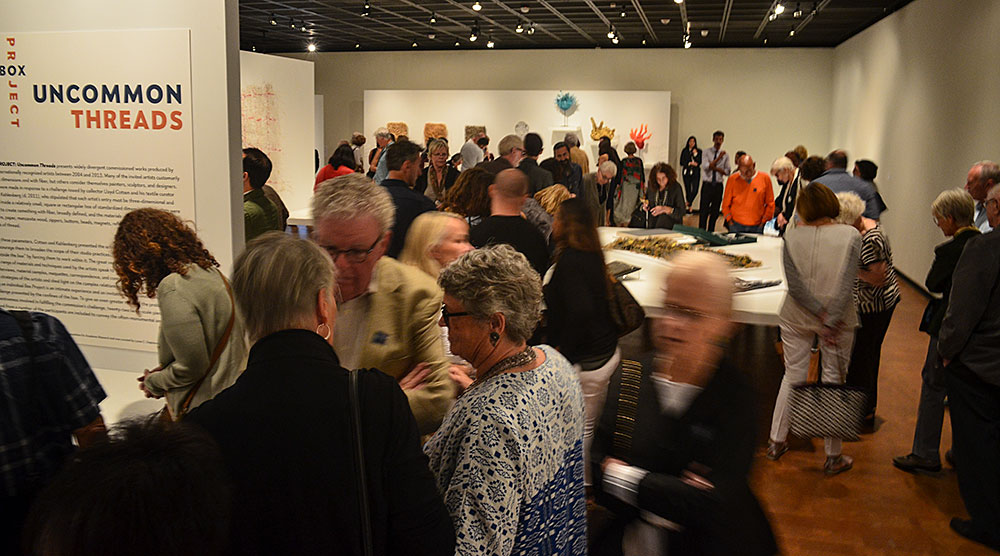

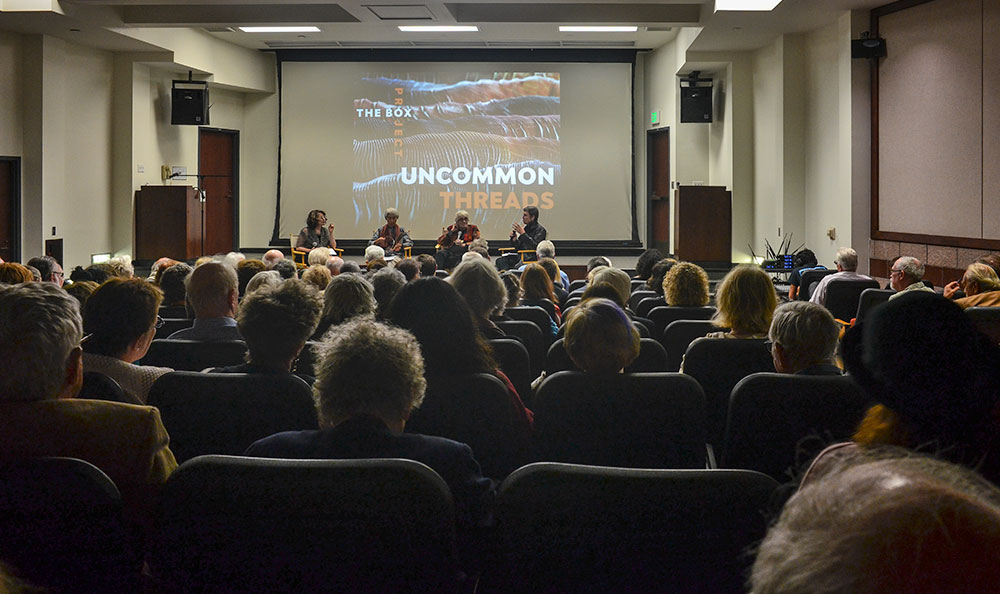
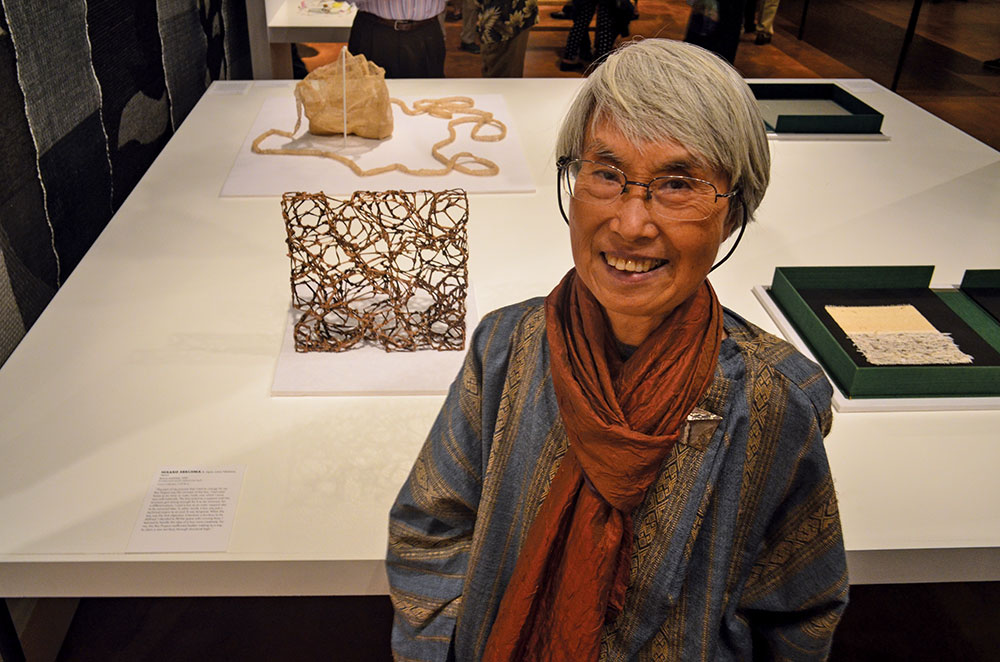
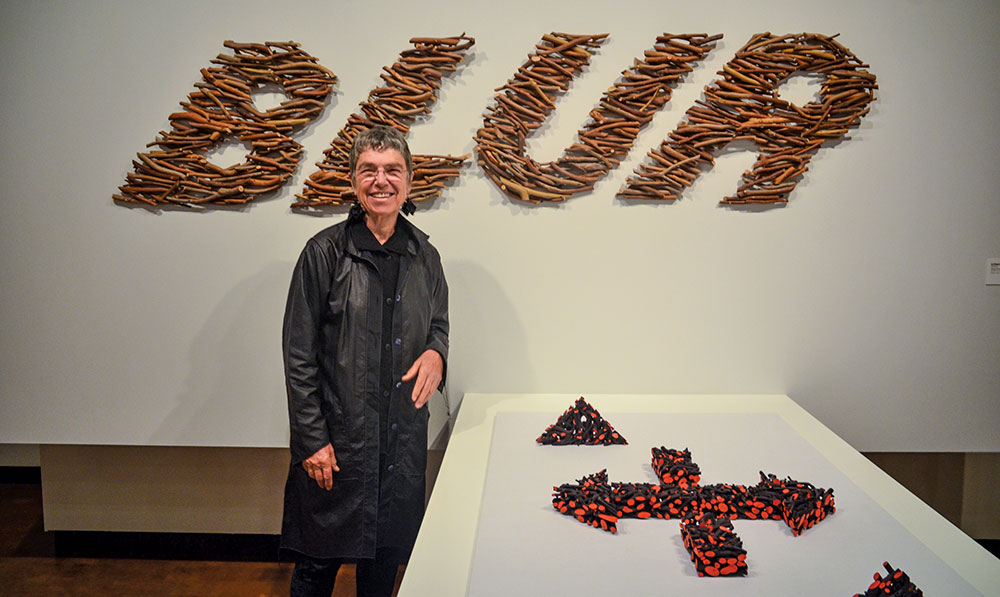


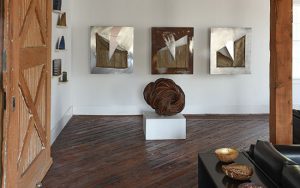

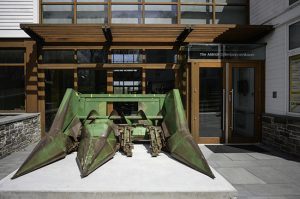

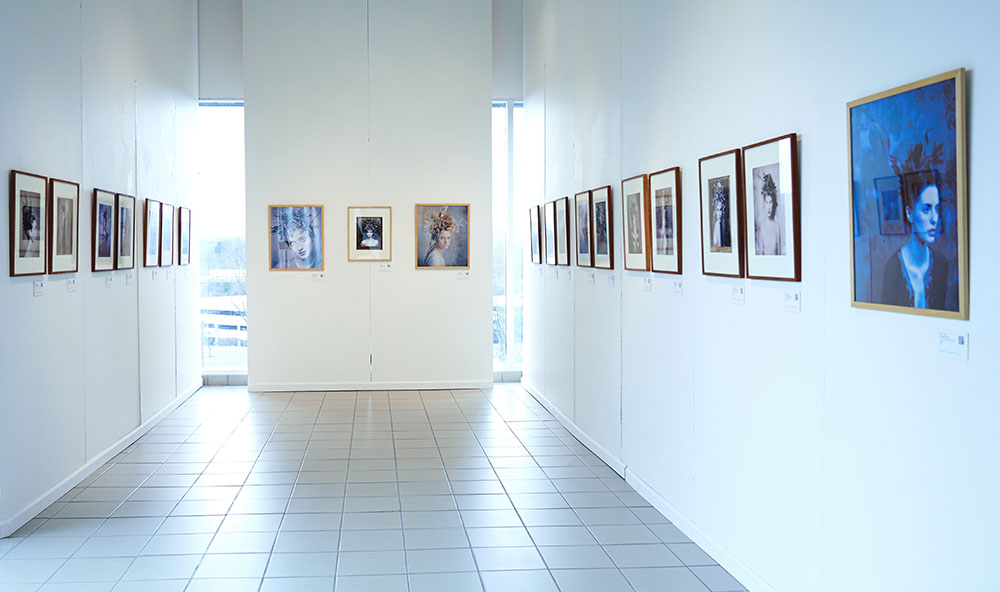

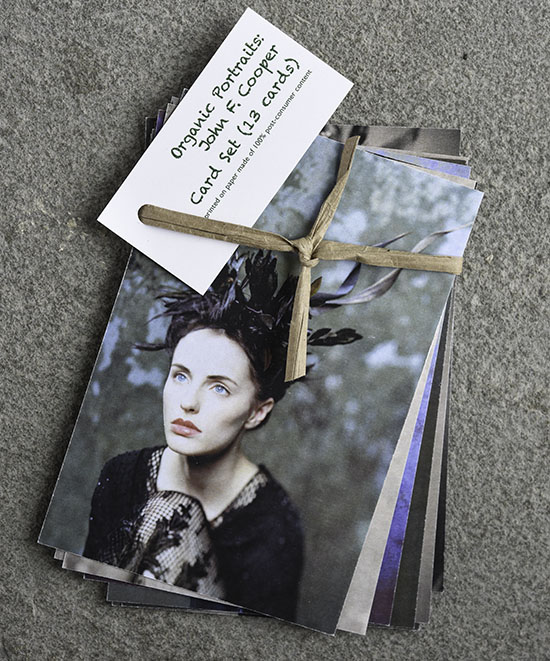

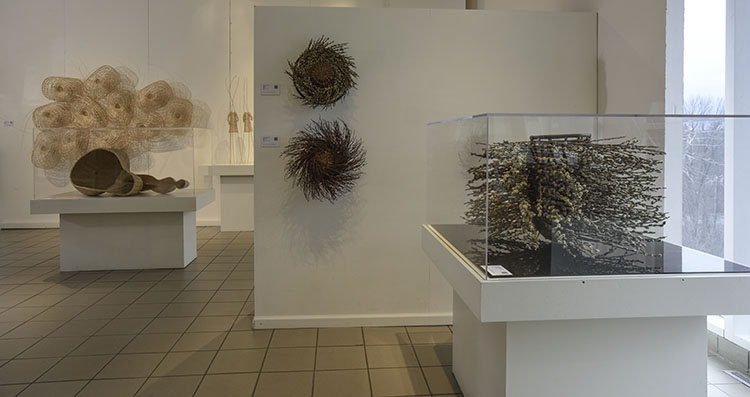
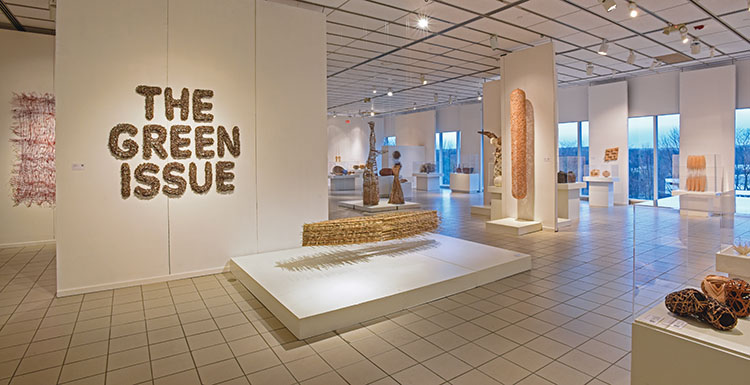
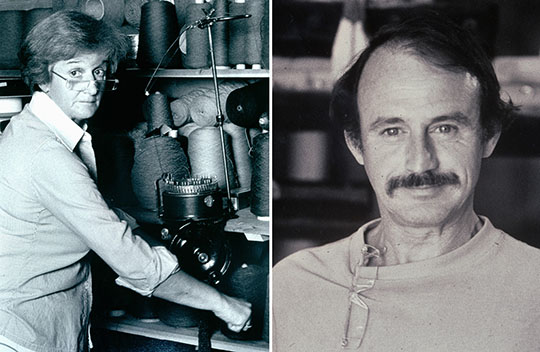
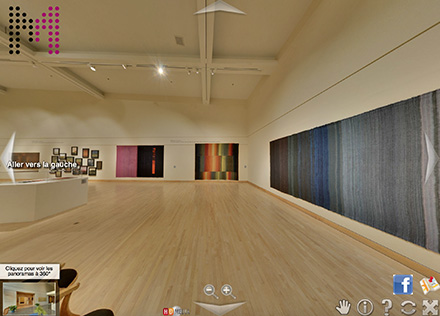




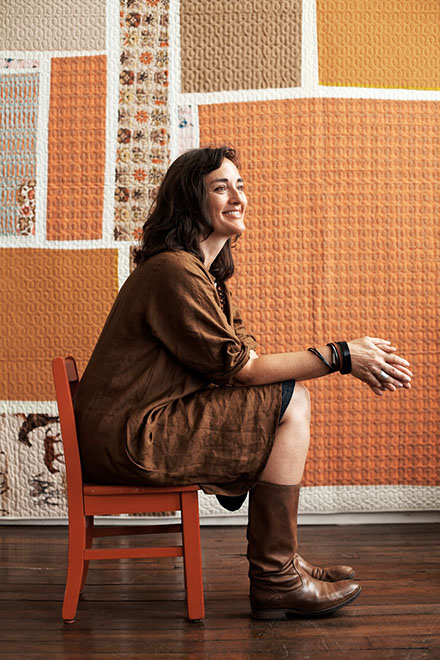
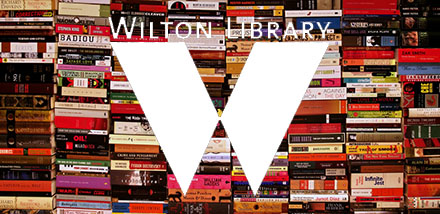

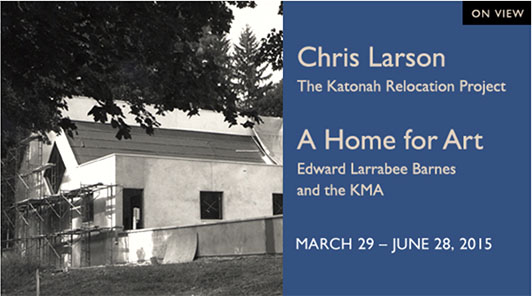



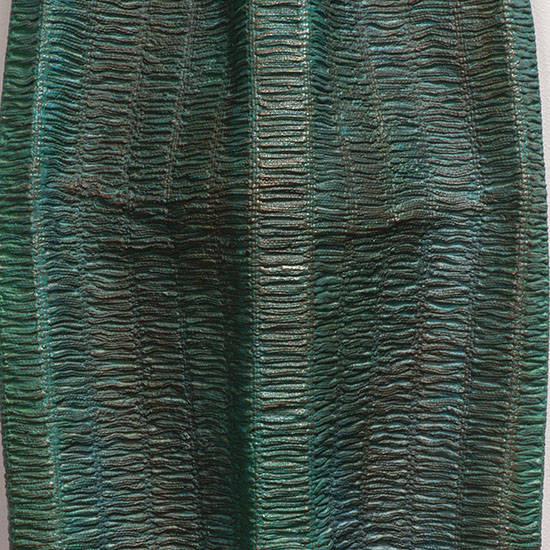
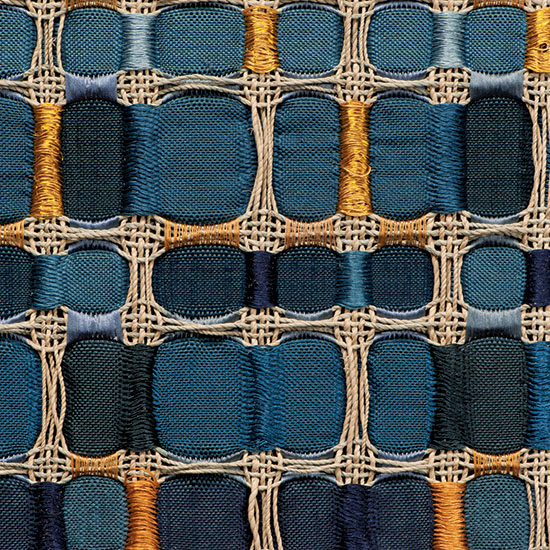
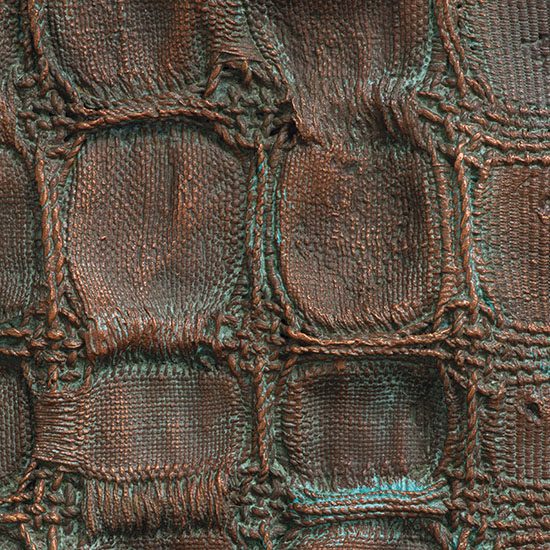
The Resurgence of Interest in Fiber Sculpture and Art Textiles Will Continue in 2015
Last year was an extraordinary one for those of us who appreciate contemporary art fiber and art textiles. More than 10 exhibitions opened in the US and abroad. In October, the art newspaper reported that “textiles are gaining international stature in art museums” and further that “[c]ommercial interest is on the rise,” quoting art advisor Emily Tsingou: “Textile [art] has entered the mainstream.” Soft Fabrics-Have Solid Appeal. Below is a roundup of exhibitions and reviews from last year and a guide to what to expect in 2015.
Mainstream attention began with the coverage of Sheila Hicks‘ inclusion
Sheila Hicks, Pillar of Inquiry/Supple Column, 2013-14 (installation view, Whitney Museum of American Art, New York). Photograph by Bill Orcutt
in the Whitney Biennial in March and was followed by coverage of the restoration of her remarkable 1960s tapestries at the Ford Foundation in New York Sheila Hicks Tapestries to Again Hang at Ford Foundation. In June, the Art Institute of Chicago’s textile galleries reopened, featuring 96-year-old Ethel Stein’s work, in Ethel Stein, Master Weaver.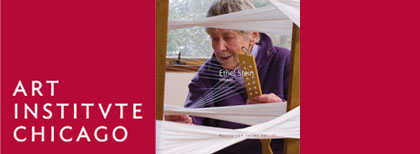
September saw three fiber-related exhibitions; the Museum of Arts and Design opened What Would Mrs. Webb Do? A Founder’s Vision (closes
February 8, 2015),Kay Sekimachi, Ed Rossbach, Françoise Grossen, Katherine Westphal and others Museum of Art Design installation of What Would Mrs Webb Do?, Photo by Tom grotta
February 8, 2015), which featured significant textiles from the permanent collection by Anni Albers, Kay Sekimachi, Katherine Westphal, Ed Rossbach, Françoise Grossen and Trude Guermonprez, while The Drawing Center’s: Thread-Lines offered Anne Wilson creating fiber art in situ
Ann Wilson’s In Situ Performance at the Drawing Center, photo by Tom Grotta
together with a collection of works by Lenore Tawney, Louise Bourgeois and others. Contemporary 108 in Tulsa, Oklahoma, featured a series of large photographic weavings by Aleksandra Stoyanov of the Ukraine
Contemporary 108 in Tulsa, Oklahoma, curated from the 2013 “Aleksandra Stoyanov” Tefen Open Museum, Israel exhibition. photo copyright Tefen Open Museum
and now Israel, described as “warp and weft paintings.”
In October, Fiber: Sculpture 1960 – present, opened at the Institute of Contemporary Art in Boston with works by 34 artists including
Fiber: Sculpture 1960 — present opening, photo by Tom Grotta
Magdalena Abakanowicz, Ritzi Jacobi and Naomi Kobayashi. The Boston Globe called the exhibition “[s]plendid, viscerally engaging…groundbreaking;” the exhibition catalog (available at browngrotta.com) was pronounced by Blouin art info, “an amazing resource for anyone interested in learning more about the medium.” Art Info – Art in the Air Fiber Sculpture 1960 Present October also saw a survey of the work of sculptor and poet, Richard Tuttle, at the Tate in London, Richard Tuttle:
I Don’t Know, Or The Weave of Textile Language in which Tuttle investigated the importance of textiles throughout history, across his remarkable body of work and into the latest developments in his practice. Tate Modern – Richard Tuttle I Don’t Know or Weave Textile Language
Throughout the year, Innovators and Legends, with work by 50 fiber
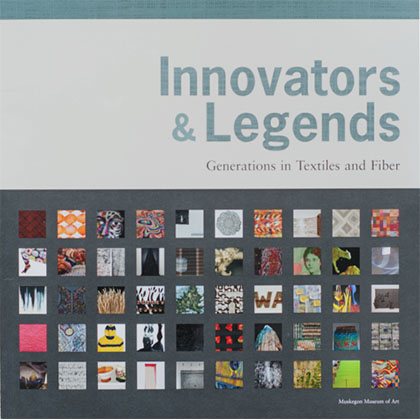
artists, including Adela Akers, Nick Cave, Katherine Westphal and Sherri Smith toured the US, exhibiting at museums in Colorado, Iowa and Kentucky. The fiber fanfest culminated at Art Basel in Miami Beach in December, where Blouin’s Art Info identified a full complement of fiber works and textiles in its listing, “Definitive Top 11 Booths, “ including Alexandra da Cunha’s compositions of mass-produced beach towels and various colored fabrics at Thomas Dane Gallery, a Rosemarie Trockel embroidered work at Galerie 1900-2000, marble and dyed-fabric pieces by Sam Moyer at Galerie Rodolphe Janssen and woven paintings by Brent Wadden at Mitchell-Innes & Nash Blouin Art info – The Definitive Top-11 Booths at Art Basel Miami Beach.
And what’s ahead in 2015?
More auctions and exhibitions that include fiber sculpture and art textiles are scheduled for 2015. Fiber: Sculpture 1960 – present will
open at the Wexner Center for the Arts, Columbus, Ohio on February 7th and travel to the Des Moines Art Center, Iowa in May.
Sonia Delaunay Prismes electriques 1914 Centre Pompidou Collection, Mnam / Cci, Paris © Pracusa 2013057
dedicated her life to experimenting with color and abstraction, bringing her ideas off the canvas and into the world through tapestry, textiles, mosaic and fashion.
Also in April, the Museum of Arts and Design will host Pathmakers:
Lenore Tawney in her Coenties Slip studio, New York, 1958.
Courtesy of Lenore G. Tawney Foundation; Photo by David Attie
Women in Art, Craft and Design, Midcentury and Today, featuring work by Sheila Hicks, Lenore Tawney and Dorothy Liebes http://madmuseum.org/exhibition/pathmakers.
In June, the Toms Pauli Foundation in Lausanne, Switzerland will celebrate the International Tapestry Biennials held there from 1962 to 1995 and display work by the Polish textile artist and sculptor Magdalena Abakanowicz, in an exhibition entitled, Objective Station.
1995 and display work by the Polish textile artist and sculptor Magdalena Abakanowicz, in an exhibition entitled, Objective Station.
Also this summer, the Musée d’Art Contemporain de Baie St Paul in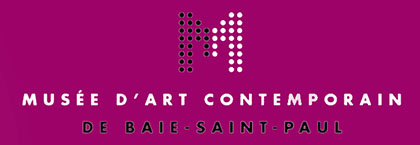
Mariette Rousseau Vermette Portrait by Tom Grotta
Quebec, Canada will examine the work of Mariette Rousseau-Vermette, who participated in five of the Lausanne Biennials.
From April 24 – May 3, 2015, browngrotta arts will host Influence and Evolution, Fiber Sculpture then and now at our barn/home/gallery space in Wilton, Connecticut. In its 27-year history, browngrotta arts
Françoise Grossen, From the Mermaid Series IV, 1983, photo by Tom Grotta
including Magdalena Abakanowicz, Lia Cook, Kay Sekimachi and Françoise Grossen, with works from a later generation of artists, all born after 1960, through whom fiber sculpture continues to evolve. These artists, including María Eugenia Dávila and Eduardo Portillo of Venezuela, Stéphanie Jacques of Belgium and Naoko Serino of Japan, work in a time when classification of medium and material presents less of a constraint and fiber and fiber techniques can be more readily explored for their expressive potential alone.
“It is rare to find so many inventive, compelling works in one show, and it astounds that many are so little known,” wrote Kirsten Swenson in Art in America, about Fiber: Sculpture 1960 – present, in October 2014. Art in America Magazine – reviews: Fiber Sculpture 1960-present. This spring, in Influence and Evolution, browngrotta arts will offer dozens more significant works of fiber art for collectors to appreciate and new audiences to discover — more than two dozen works by fiber pioneers and another 30 more recent fiber explorations. We hope you will visit the exhibition, order the catalog or both. Please contact us for more information about what’s in store. art@browngrotta.com